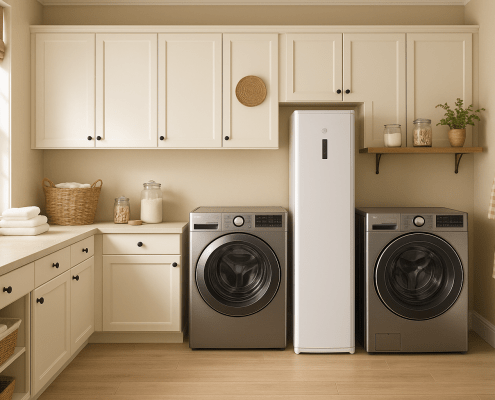How to Fix Lint Buildup in a Laundry Steam Closet
Steven E / Friday September 5, 2025
If your laundry steam closet isn’t steaming like it used to, or clothes come out a little musty instead of crisp, lint buildup is a prime suspect. While steam closets don’t roast lint the way a traditional dryer does, they still move air, condense moisture, and pull tiny fibers off garments. Over time, lint and dust can choke air paths, clog fine steam outlets, and gunk up filters and drains. The good news: with a handful of household tools and an hour of easy maintenance, you can restore performance and keep your steam closet running like new.
Why Lint Builds Up in a Steam Closet
Even though steam closets refresh rather than tumble-dry, the process still loosens micro-fibers from fabrics. Those fibers travel with the airflow and condensing steam, landing on:
- Air intake filters and fine mesh screens
- Interior vents and louvers near the fan outlet
- Steam nozzles (the tiny holes that release steam)
- Door gaskets and rails, where moisture collects and traps lint
- Condenser surfaces and drain paths, which capture lint as steam condenses to water
Add a little dust from the room and mineral scale from hard water, and you’ll eventually see longer cycles, weak steam, odors, or damp results.
Signs You’ve Got a Lint Problem
- “Refresh” or “Sanitary” cycles take noticeably longer
- Steam looks weak or sputtery; garments don’t feel revived
- Musty or “wet towel” smell after a cycle
- Visible fuzz on vents, door seals, or filter mesh
- Water drips or small puddles (a linty drain can slow or block flow)
- The unit runs louder than before (fan straining against restriction)
Safety First
- Unplug the steam closet or switch off the dedicated breaker.
- Let it cool for 30 minutes if it ran recently; steam lines can stay hot.
- Turn off the water supply (if your model is plumbed).
- Wear gloves and eye protection, you’ll be around fine dust and possibly vinegar solution.
- Keep a dry towel handy for drips.
Tools & Supplies You’ll Need
- Vacuum with a crevice tool and a soft brush attachment
- Soft brush (nylon) or clean, dry paintbrush
- Microfiber cloths and cotton swabs
- Small, soft bottle brush or pipe cleaners
- Warm, mildly soapy water
- Distilled white vinegar (for mineral and biofilm cleanup)
- A turkey baster or large syringe (helpful for flushing drains)
- Flashlight
- Small screwdriver set (Phillips and Torx sizes your model uses)
Know Your Steam Closet’s Lint Areas
Every brand looks a little different, but most units share these components:
- Air Intake Filter: Usually behind a small panel or grille; captures dust and fibers before air reaches the fan.
- Fan + Outlet Vent: Pushes conditioned air through the cabinet; louvers can collect fuzz.
- Steam Generator & Nozzles: Tiny outlets that can clog from lint or scale; they need gentle attention.
- Condenser/Drain Path: Where steam turns back to water; lint and soap residues can settle here.
- Door Gasket & Rails/Hangers: Moisture + fibers = lint paste if left alone.
- Water Tanks (if not plumbed): Intake and drain tanks on portable models, both can accumulate fine lint.
You don’t have to disassemble the machine to clean most of this. We’ll go from easiest to deepest cleaning.
Step-by-Step: Deep-Clean to Remove Lint
Power Down and Empty the Cabinet
Remove all clothes, hangers, and shelves/pants press attachments. Wipe any obvious fuzz you see; it’ll keep dust from spreading when you start vacuuming.
Clean the Air Intake Filter
- Locate the intake filter panel; open per your model’s design.
- Pull out the filter or mesh screen.
- Vacuum both sides with a soft brush. If it’s washable, soak it in warm, mildly soapy water for 10–15 minutes, rinse, and let it air-dry completely.
- If the filter is foam and brittle or torn, replace it, they’re inexpensive and make a big performance difference.
Vacuum Interior Vents and Louvers
- Using the crevice tool, gently vacuum around interior vents, the fan outlet louver, and any visible duct edges.
- Use a soft brush attachment to lift dust; don’t press hard or deform plastic fins.
- A soft paintbrush can loosen lint from tight corners; follow immediately with the vacuum.
Wipe Down the Door Gasket and Rails
- Mix a solution of warm water with a splash of vinegar.
- Wipe the door gasket, corners, and the rails/hanger tracks.
- Use cotton swabs in tight channels. You’ll be surprised how much lint hides here.
Carefully Clean Steam Nozzles
- Shine a flashlight at the steam outlets.
- If your nozzles have removable caps, gently take them off. Soak the caps (and any removable nozzle tips) in a 1:1 vinegar-water mix for 20 minutes, then rinse and dry.
- If nozzles are fixed, dampen a cotton swab with vinegar solution and lightly touch around the holes.
- Don’t poke hard metal into the orifices; enlarging them will weaken steam performance. A toothpick is okay for surface lint only.
Clear the Condenser and Drain Path
- Find the drain channel or cup at the cabinet’s base (designs vary).
- Vacuum loose lint.
- Flush with warm water using a turkey baster or syringe to push debris toward the drain. If accessible, run a pipe cleaner gently through the short drain run.
- For plumbed drains, place a small container to catch flush water if there’s a service cap; crack it open slowly and clear debris.
Clean the Water Tanks
- Empty the intake and drain tanks.
- Rinse both with warm water; swish vigorously.
- If you see slime or fine fibers on tank walls, add a little vinegar, shake, rinse, and dry.
Interior Polish and Reassembly
- Wipe the entire cabinet with a slightly damp microfiber cloth, then a dry one.
- Reinstall filters, nozzle caps, shelves, and attachments.
- Turn water back on (if plumbed). Plug the unit back in.
Run a “Flush” Cycle
If your model has a maintenance or “self-clean/refresh” cycle, run it empty. Otherwise, run a short refresh with distilled water in the tank. This clears loosened lint and any residual vinegar scent.
Prevent Lint Buildup: Simple Maintenance
- Quick wipe of the door gasket and base channel
- Empty the drain tank (if your model has one)
- Remove visible fuzz from vents and rails
- Leave the door slightly open after use to let humidity escape
- Avoid heavily shedding items (new towels) unless you pre-wash and lint-roll them
Pro Tips for Lint-Heavy Households
- Use garment bags for sweaters and fleece to limit fiber transfer.
- Lint roll or brush items before you steam; preventive removal is easier than cleanup.
- Distilled water reduces mineral scale that can trap lint at the nozzle exits.
- Room air quality matters: if your laundry area is dusty, your intake filter will load faster. Vacuum that space regularly.
Where To Find Us
If you need any replacement parts for your appliances, you can enter your model number at AppliancePartsPros.com to locate and order them quickly. Most orders arrive in just two business days, and we have tons of great information in our repair help section and YouTube videos to help you troubleshoot.
Stay connected with the latest DIY tips, tutorial videos, and repair guides by following us on Facebook, Instagram, and Twitter. We love hearing about your repair stories and successes. If you need more help or want personalized guidance, feel free to contact or call us at 877-477-7278. We’re ready to help you take on your next project with confidence!
Since 1999, AppliancePartsPros.com has helped millions of people repair their broken appliances by providing high-quality original parts at well below retail prices, free support and troubleshooting, and award-winning customer service from an expert, friendly, US-based customer support team!
Looking for the right part? Enter your appliance model number below to find the exact match and get your appliance running like new again!
With nearly a decade of experience in providing top-notch customer service regarding appliance parts and repair, Steven enjoys sharing practical advice, troubleshooting tips, and interesting information to help readers stay informed.






Leave a Reply
Want to join the discussion?Feel free to contribute!